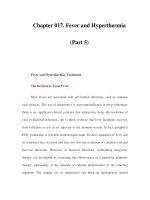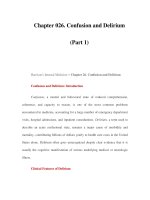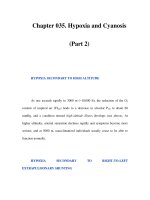Chapter 071. Vitamin and Trace Mineral Deficiency and Excess (Part 8) pdf
Bạn đang xem bản rút gọn của tài liệu. Xem và tải ngay bản đầy đủ của tài liệu tại đây (52.63 KB, 5 trang )
Chapter 071. Vitamin and Trace Mineral
Deficiency and Excess
(Part 8)
Flavonoids
Flavonoids constitute a large family of polyphenols that contribute to the
aroma, taste, and color of fruits and vegetables. Major groups of dietary flavonoids
include anthocyanidins in berries; catechins in green tea and chocolate; flavonols
(e.g., quercitin) in broccoli, kale, leeks, onion, and the skins of grapes and apples;
and isoflavones (e.g., genistein) in legumes. Isoflavones have a low bioavailability
and are partially metabolized by the intestinal flora. The dietary intake of
flavonoids is estimated to be between 10 and 100 mg/d, although this is almost
certainly an underestimate due to the lack of knowledge of their concentrations in
many foods. Several flavonoids have been shown to have antioxidant activity and
to affect cell signaling. From observational epidemiologic studies and from limited
clinical human and animal studies, flavonoids have been postulated to play a role
in the prevention of several chronic diseases, including neurodegenerative disease,
diabetes, and osteoporosis. The ultimate importance and usefulness of their
compounds against human disease have yet to be demonstrated.
Vitamin A
Vitamin A, in the strictest sense, refers to retinol. However, the oxidized
metabolites, retinaldehyde and retinoic acid, are also biologically active
compounds.
The term retinoids includes all molecules (including synthetic molecules)
that are chemically related to retinol. Retinaldehyde (11-cis) is the essential form
of vitamin A that is required for normal vision, whereas retinoic acid is necessary
for normal morphogenesis, growth, and cell differentiation.
Retinoic acid does not function in vision and, in contrast to retinol, is not
involved in reproduction. Vitamin A also plays a role in iron utilization, humoral
immunity, T cell–mediated immunity, natural killer cell activity, and
phagocytosis. Vitamin A is commercially available in esterified forms (e.g.,
acetate, palmitate) since it is more stable as an ester.
There are more than 600 carotenoids in nature, and approximately 50 of
these can be metabolized to vitamin A. β-Carotene is the most prevalent
carotenoid in the food supply that has provitamin A activity.
In humans, significant fractions of carotenoids are absorbed intact and are
stored in liver and fat. It is now estimated that 12 µg or greater of dietary β-
carotene is equivalent to 1 µg of retinol, whereas 24 µg or greater of other dietary
provitamin A carotenoids (e.g., cryptoxanthin, α-carotene) is equivalent to 1 µg of
retinol.
Metabolism
The liver contains approximately 90% of the vitamin A reserves and
secretes vitamin A in the form of retinol, which is bound to retinol-binding
protein. Once this has occurred, the retinol-binding protein complex interacts with
a second protein, transthyretin.
This trimolecular complex functions to prevent vitamin A from being
filtered by the kidney glomerulus, to protect the body against the toxicity of retinol
and to allow retinol to be taken up by specific cell-surface receptors that recognize
retinol-binding protein.
A certain amount of vitamin A enters peripheral cells even if it is not bound
to retinol-binding protein. After retinol is internalized by the cell, it becomes
bound to a series of cellular retinol-binding proteins, which function as
sequestering and transporting agents as well as co-ligands for enzymatic reactions.
Certain cells also contain retinoic acid–binding proteins, which have sequestering
functions but also shuttle retinoic acid to the nucleus and enable its metabolism.
Retinoic acid is a ligand for certain nuclear receptors that act as
transcription factors. Two families of receptors (RAR and RXR receptors) are
active in retinoid-mediated gene transcription.
Retinoid receptors regulate transcription by binding as dimeric complexes
to specific DNA sites, the retinoic acid response elements, in target genes (Chap.
332). The receptors can either stimulate or repress gene expression in response to
their ligands. RAR binds all-trans retinoic acid and 9-cis retinoic acid, whereas
RXR binds only 9-cis retinoic acid.
The retinoid receptors play an important role in controlling cell
proliferation and differentiation. Retinoic acid is useful in the treatment of
promyelocytic leukemia (Chap. 104) and is also used in the treatment of cystic
acne because it inhibits keratinization, decreases sebum secretion, and possibly
alters the inflammatory reaction (Chap. 53).
RXRs dimerize with other nuclear receptors to function as coregulators of
genes responsive to retinoids, thyroid hormone, and calcitriol. RXR agonists
induce insulin sensitivity experimentally, perhaps because RXR is a cofactor for
the peroxisome-proliferator-activated receptors (PPARs), which are targets for the
thiazolidinedione drugs such as rosiglitazone and troglitazone (Chap. 338).









